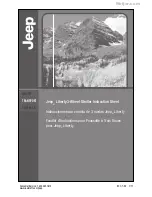
10-5
Cisco Wireless LAN Controller Configuration Guide
OL-1926-06OL-9141-03
Chapter 10 Configuring Radio Resource ManagementWireless Device Access
Overview of RF Groups
RRM Benefits
RRM produces a network with optimal capacity, performance, and reliability while enabling you to
avoid the cost of laborious historical data interpretation and individual lightweight access point
reconfiguration. It also frees you from having to continually monitor the network for noise and
interference problems, which can be transient and difficult to troubleshoot. Finally, RRM ensures that
clients enjoy a seamless, trouble-free connection throughout the Cisco unified wireless network.
RRM uses separate monitoring and control for each deployed network: 802.11a and 802.11b/g. That is,
the RRM algorithms run separately for each radio type (802.11a and 802.11b/g). RRM uses both
measurements and algorithms. RRM measurements can be adjusted using the monitor intervals specified
in
Table 10-1
, but they cannot be disabled. RRM algorithms, on the other hand, are enabled
automatically but can be disabled by statically configuring channel and power assignment. The RRM
algorithms run at a specified updated interval, which is 600 seconds by default.
Note
RRM measurements are postponed on a per access point basis where traffic remains in the platinum QoS
queue, if there was voice traffic in the last 100 ms.
Overview of RF Groups
An RF group, also known as an
RF domain, is a cluster of controllers that coordinates its dynamic RRM
calculations on a per 802.11-network basis. An RF group exists for each 802.11 network type. Clustering
controllers into RF groups enables the RRM algorithms to scale beyond a single controller.
Lightweight access points periodically send out neighbor messages over the air. The RRM algorithms
use a shared secret that is configured on the controller and sent to each access point. Access points
sharing the same secret are able to validate messages from each other. When access points on different
controllers hear validated neighbor messages at a signal strength of –80 dBm or stronger, the controllers
dynamically form an RF group.
Note
RF groups and mobility groups are similar in that they both define clusters of controllers, but they are
different in terms of their use. These two concepts are often confused because the mobility group name
and RF group name are configured to be the same in the Startup Wizard. Most of the time, all of the
controllers in an RF group are also in the same mobility group and vice versa. However, an RF group
facilitates scalable, system-wide dynamic RF management while a mobility group facilitates scalable,
system-wide mobility and controller redundancy. Refer to
Chapter 11
for more information on mobility
groups.
RF Group Leader
The members of an RF group elect an RF group leader to maintain a “master” power and channel scheme
for the group. The RF group leader is dynamically chosen and cannot be selected by the user. In addition,
the RF group leader can change at any time, depending on the RRM algorithm calculations.
















































